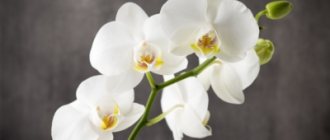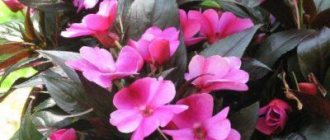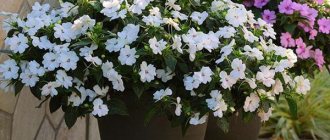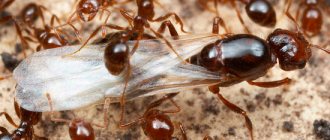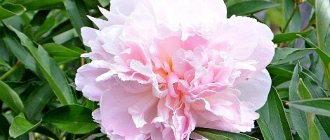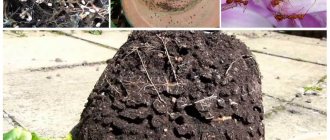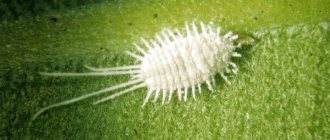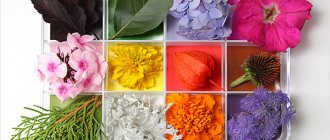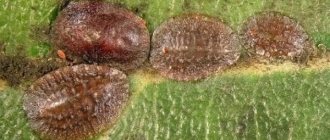Ants do not cause serious harm to peonies; they feed on the sweet nectar that forms on the buds. Flowers most often bloom normally, at the usual time. However, insects cannot be called completely harmless; they bring aphids to flowers in large quantities, and aphids damage the tissue of young leaves, destroy the smallest buds and are carriers of dangerous diseases.
To be closer to the food source, ants can settle near peony bushes; if their nest is located directly in the root zone, the plants will die over time due to malnutrition or the development of rot. Why do ants appear on peonies, how to get rid of them, how to treat buds and flowers: chemicals, traps and folk remedies.
Why do ants appear on peonies?
The ants' diet largely consists of carbohydrates, which they obtain by feeding on honeydew and the sweet nectar of certain plants. Insects are attracted to the sharp, sweet aroma of peony, emanating even from unopened flowers. Ants that settle on buds feed on the juice that has already been released; very rarely they gnaw through the bud in search of nectar.
On a note! Buds damaged by ants dry out or bloom, but the flowers become deformed and discolored.
If insects have already settled on peony bushes, they will bring aphids to them, which, in the process of vital activity, secrete honeydew - a food source for ants. Aphids reproduce very quickly, they destroy young leaves, buds and even peony flowers. Due to impaired photosynthesis, plants lose immunity to infections and cold resistance decreases.
Causes of ants
Ants appear on peony buds only where favorable conditions are created for them. The presence of food and a protected place leads to active growth of the colony.
Ants on buds
Types of insects
Not all types of ants are common on peonies. Garden crops are affected only by small insects. More often than others, you can find garden and dark brown turf ants on flowers. They are attracted by the sweet smell that the buds and nectar of flowers emit. Red forest ones are less common.
Black and brown ants are small in size. Their body length is slightly more than 4 mm.
The attractiveness of peonies to ants
There are several reasons why ants love peonies:
- Food. Ants are attracted to the sweet smell of flowers. They feed on nectar that covers unopened buds.
- Shelter. Peonies reliably protect anthills from the scorching sun, wind and other weather phenomena.
- Pasture for aphids. Ants live in symbiosis with aphids. Aphids develop well on young shoots of flowers. This gives the insects an additional source of food.
Important! The aroma is released not only by flowers, but also by closed buds. The smell attracts insects when the bush has not yet bloomed.
Benefits and harms of insects
Not all gardeners believe that ants on peonies should be controlled. Some argue that insects are beneficial to flowers.
There are two main problems that result from ants:
- Damage to peony buds. Insects gnaw sepals and leaves, which leads to their drying out.
- Distribution throughout the area. As the colony grows, the ants spread throughout the entire area.
Benefits and harms of insects
Despite the disadvantages, ants also have benefits. They feed on sweet nectar, which forms a film on the bud. This makes it easier to bloom.
How to get rid of ants before peonies bloom
To ensure that insects cause as little harm as possible, stems with small, newly formed buds (the size of a pea) are treated with various repellents. They use special gels - Agrus, Cleanbeit, Liquidator or folk remedies. This method has a significant disadvantage: during the budding period it often rains, water will wash away the substances, if you do not coat the stems again, the ants will reach the target again.
A good alternative is wood ash; as soon as the stems begin to grow, the powder is scattered in a circle near the trunk; it will not only repel ants, but will also nourish the plants. At the same time, make sure that there is no excess of potassium, phosphorus and calcium; in this case, the product cannot be used, otherwise the development of plants will be disrupted. Before and at the beginning of flowering, baits, traps and barriers are placed around the bushes.
The benefits and harms of ants in a summer cottage
Usually ants do not harm the flower, although many gardeners can hear the opposite statement. Sweet tooths only feed on the juice and do not damage the plant. It is believed that ants on a summer cottage are needed to a certain extent:
- they destroy harmful caterpillars, larvae and slugs, thereby protecting the plant (including peonies) from garden and garden pests;
- ants help improve the condition of the soil, affecting it at the structural level: a large anthill increases the amount of phosphorus in the soil tens of times, and potassium almost three times;
- microelements pass into soluble forms from insoluble ones, which means easier plant nutrition).
However, ants in the flower garden and vegetable garden can become a real disaster for a florist, gardener or gardener:
- pests enjoy feasting on plant seeds and spoil seedlings;
- insects can gnaw the petals and sepals so that the sweet juice is released more actively, thereby spoiling the flowers;
- these arthropods can attack not only peony flowers, but also their buds, which as a result deteriorate before they have time to open, the blossoming flowers become disfigured and ugly;
- ants can transport harmful fungi to the peony, as they are often carriers of the latter;
- where ants have settled, the acidity of the soil increases, which is not always good for the flora;
- ants carry the seeds of a large number of plants, among which there are both unwanted weeds in the garden and malicious weeds, for example, hoofweed, celandine, and corydalis.
Video: is it necessary to get rid of ants on peonies?
How to treat peony buds against ants
All means are good in the fight against ants, but you need to consider what plants, shrubs or trees are located in the neighborhood. Flowers are not treated with chemicals if there are apiaries nearby, berries, fruits, vegetables (with fruits already set) and herbs grow. The packages contain detailed information about the time period between use of the products and harvest.
Chemicals are not used if there is no goal to completely get rid of ants; in addition to harm, they bring benefits, they eat the larvae and caterpillars of some pests. Folk remedies are used throughout the summer; they are harmless to other plants, beneficial insects and the environment. Safe substances give a weak and short-term effect; treatments are repeated every 5–10 days.
Prevention of ants
Thrips on roses - how to get rid of parasites
Ants on peonies are a serious problem. Preventive measures can prevent their spread and occurrence:
- Inspection of plants. Flowers are inspected once every 1-2 weeks. It is important to promptly notice the appearance of the first insects or aphids.
- Soil cultivation. The soil around the peonies is dug up 1-2 times per season. When digging, add ash.
- Planting repellent plants. In the immediate vicinity of peonies, it is recommended to make beds or flower beds with repellent plants. Favorable neighbors are basil, mustard, cilantro, lavender, lemon balm, rosemary, garlic, and mint. Decorative ones include marigolds, nasturtiums, daisies.
- Plant processing. When the first insects appear, the plants and soil around the bushes are treated with chemical compounds, folk remedies containing ammonia, ash, garlic, and traps are also installed.
- Removing anthills. If an anthill has managed to form, it is dug up and removed from the site. The bush and soil are treated with chemicals.
- Scheduled processing. In spring and autumn, routine treatment of the entire area with insecticides is carried out.
Preventive treatment of the flower garden
Peonies are amazing flowers, but insect bites can ruin the whole experience. Carrying out preventive measures in combination with simple care allows you to solve the problem of the appearance of ants and achieve prolonged flowering of the crop every season.
All methods of fighting ants on peonies
It is useless to shake insects off peonies; a more effective method is to wash them off. Take settled water, heated by the sun, add a little laundry soap or dishwashing detergent (20 g per 5 liters of water), with a soft cloth, and carefully wash the buds. The procedure is permissible only in the morning and evening hours; if you rinse the flowers during the day, burns may remain on the sepals. The method gives a good result if there are few ants, but if there are a large number of individuals, they carry out a complex fight.
Store-bought drugs
When choosing chemicals, take into account that aerosols give a temporary effect; dead ants will quickly be replaced by new ones. Gels and most powder products (for preparing solutions) act on the digestive system of insects, substances are transferred from one individual to another, most often this leads to infection of the entire colony.
What drugs give good results:
- Ant-eater. A powder or liquid product containing diazinon, a potent poison that attacks the intestines of ants. In stores you can often find ampoules, 1 is enough for 10 liters of water.
- Expel. A German drug based on chlorpyrifos, it is also produced in the form of powder and emulsion. Use the product strictly according to the instructions, which may vary (depending on the form of release of the substance).
- Muratsid or Ant. They act in the same way as the first drug.
Attention! Solutions of any product cannot be stored; they are used immediately after preparation; they are used to treat bushes, soil around tree trunks, and anthills.
The downside of chemicals is that they are harmful to bees and other beneficial insects, as well as animals and birds. Failure to follow the instructions for use can lead to serious poisoning and other dangerous consequences (rash, irritation of the mucous membranes and skin). Plants are treated in the morning or evening in dry, windless weather; gloves, a mask and closed clothing are worn. Other commonly used drugs are Inta-vir, Grom, Vallar, Kapkan and Karbofos.
Traps
When placing baits with toxic substances, make sure that beneficial insects cannot get into them. For example, they take small plastic bottles or jars with rubber lids and make small holes so that only small individuals can fit through them freely.
Various preparations for traps can be bought in the store; the following have proven themselves to be good:
- Blattanex Ant Bait. Contains food additives, sugar. The ants eat the bait, carry it to their nests, spreading it throughout the entire anthill. The first individuals die within a few days; complete destruction takes from 2 to 8 weeks (in large numbers). The granules are scattered dry into prepared containers or in places where there are large concentrations of ants.
- Ameisen Aeroxon. It attracts insects and affects their nervous system, the ants carry it to the queen and brood, and within a short time the entire colony dies. With this remedy you can get rid of the problem within a day.
- Combat and Raptor. Special preparations consisting of several ready-made traps.
Purchased products are replaced with a composition of 5 g of boric acid, 50 g of honey and 50 g of water, the mixture is mixed until a homogeneous mass is obtained, transferred to a trap or scattered around the bushes. Having smelled the “treat”, the insects will leave the buds, and having tasted it, they will die. Instead of honey, you can use sugar or jam, the effect will be the same. In order not to destroy the ants, but simply to distract them from the peonies, prepare the usual sweet bait. Several small containers are filled with syrup, placed around the flower bed, and the liquid is added or changed daily.
Barriers
Barriers (ribbons, tying with cloth impregnated with insecticides, whitewashing, etc.) are more convenient to use on young trees or thin branches of shrubs, but there is also an option for peonies. A circle with a diameter of up to 16 cm is cut out of thick cardboard, a small hole is made in the center, the size of the stem, so that there is no gap left. The circle from the outer edge to the inner is cut and put on a twig, closer to the bud or flower. The bottom of the cardboard is generously greased with Vaseline.
Barriers like tires with water dug around bushes practically do not work. The first individuals fall into the trap, the rest break through passages under the barrier and freely reach the buds. This method of control is dangerous; in order not to lose their food source, insects build homes right in the root zone, and this inevitably leads to the death of peonies.
Repellent odors
A good way to prevent the appearance of ants on peonies is to use plants whose aroma they cannot tolerate: wormwood, tansy, marigolds, garlic, lavender, parsley, mint, anise and bay leaves. The latter can be taken dry (seasonings). Infusions are prepared from repellents for spraying; some of them are planted around the perimeter of the flower garden. Rub the stems of peonies with a clove of garlic until they bloom.
Attention! You can scare away ants with tobacco infusion. A glass of cigarette butts is poured into 5 liters of hot water, left for 2-3 days, filtered and sprayed on the plants.
Chop a large head or 100 g of garlic cloves, pour in 3 liters of boiling water, leave for a day in a closed container, filter, process the leaves, buds and stems on all sides. An infusion of any of the plants proposed above is prepared in the same way; a lot of herbs are taken so that the aroma is rich. A little laundry soap is added to the finished, strained infusions, so the liquid remains on the leaves longer.
The usual interval between treatments is 5–12 days; if it rains constantly, the bushes are sprayed more often. In cases where it is not possible to visit the dacha often, you can put a rag soaked in kerosene near the bushes (in the depths of the flower garden). The sharp, pungent smell will scare away ants and other harmful insects, but you won’t be able to enjoy the delicate aroma of flowers. Ants do not like the smell of conifers, but they cannot be used in beds with peonies, the needles acidify the soil, and plants develop well only in a neutral environment.
Folk remedies for ants on peonies
If for some reason it is not possible to treat plants with special chemical insecticides and acaricides, get rid of annoying insects using various means that are in the kitchen or in the medicine cabinet. The results from them are no worse, and some give a quick and long-term effect.
Let's highlight the already proven and most effective options:
- 1 tbsp. l. vinegar essence is diluted in a bucket of water, the bushes are irrigated with the mixture, and the buds are always treated.
- Baking powder is scattered in the root zone and along the perimeter of the flower bed. Take about 50–100 g of powder per 1 m². The ants die from such a treat, but the bait is used only in dry, windless weather.
- The soil around the bushes is loosened, a repellent mixture of soda, quicklime and wood ash is scattered over the surface, the ingredients are taken in equal parts. The same mixture is sprinkled on anthills.
On a note! If there are few ants on the buds, they can be sprayed with a weak soap solution, a teaspoon is enough. shampoo per 1 liter of water.
Small anthills located near peonies are filled with boiling water with the addition of soda ash - a pack per bucket. Instead of soda, use ammonia, 100 ml is enough for the same amount of liquid. A mixture of 250 ml of dishwashing detergent, 1 liter of table vinegar, 500 ml of oil per bucket of water gives good results, pour the liquid into large anthills. A small depression is made at the top, poured gradually, then the nest is covered with polyethylene, left for a day and dug deep.
How to remove an anthill from under a peony bush
If the anthill is located directly under the roots of the peony bush or nearby, then it is logical that the ants “master” it (as the closest source of food). A small anthill (up to 30–40 cm) in diameter can be moved without causing much damage to the insects. They simply dig it up with a shovel, put it in a wheelbarrow and take it away from the site, somewhere in the forest. The soil is sprinkled with ash, baking soda or salt to get rid of the remaining individual individuals.
A less humane way is to fill the anthill with a solution of baking soda (a pack of 10 liters of water), ammonia (100 ml for the same volume), soap (250 ml of liquid soap or 200 g of shavings + a liter of table vinegar and half the amount of any vegetable oil). The liquid is poured into the anthill and covered with a plastic bag for a day, pressing the edges tightly to the ground.
What to do to prevent ants from appearing on peonies
Preventing insect attacks on flowers is much easier than fighting them. Prevention consists of regularly inspecting the area and destroying all anthills. The garden is always kept clean, garbage, sawdust, shavings, old boards, weeds, fallen leaves and other plant debris, branches are removed, and stumps from trees and shrubs are uprooted. When transplanting peonies from one place to another, wood ash is added to the holes and into the soil for backfilling. Repellent plants are planted in flower beds with peonies.
Getting rid of anthills on the site is painstaking work, but this is the only way to protect peonies. Ants are especially dangerous for weakened plants, as they are carriers of fungal infections. A constant companion of insects, aphids are capable of destroying young plants in a few days and infecting them with viral diseases. It is better to fight ants comprehensively, using various methods, this will guarantee a good result.
Did you like the post? Add it to your favorites
All your articles will be on this page.
Send the article to your social network!
Getting rid of aphids
An ant invasion is often accompanied by the presence of aphids, which sometimes cause greater harm to the plant. Gardeners advise using a decoction of fir cones and needles. To prepare it, you need to take 2 kg of plant ingredients and 8 liters of water. All components should be mixed and placed in a dark place for 7 days. It is advisable to stir the tincture periodically.
When the product is ready, you need to dilute it with water in a ratio of 1:10. The prepared solution is suitable for daily spraying of bushes and soil. To completely get rid of pests, it is necessary to carry out 2 irrigations per day for 3 days.
- An effective tincture can also be prepared from dandelions by pouring 300 grams of roots and 400 grams of leaves with 10 liters of warm water. After 3 hours, the tincture is ready for treating flower bushes and soil.
- 250 ml of vinegar diluted in a bucket of water can be used as an antiparasitic agent.
Note! Vinegar can lead to irritation and burns of the skin and mucous membranes. The treatment of peonies with the presented product must be carried out with gloves, glasses and a mask.
Description of the signs of peony pests and how to deal with them
Bronzovki
Bright beetles with a characteristic green-golden color. They feed not only on flower petals, but also on stamens and pistils.
The presence of beetles on plants and flower petals eaten by them. Most often, bronzes affect light-colored varieties of peonies with fragrant flowers.
We collect beetles directly from the bushes in the morning, when they are least active. We add Medvetox, Grom or Pochin (15 g/per 10 sq. m.) into the ground under the peonies. We spray the pest-affected flowers with a 0.3% Calypso solution.
Root-knot nematodes
These microscopic worms parasitize the root system of peonies, which is why nodular formations (galls) appear on it. Having destroyed the deformed, infected root, these pests move to healthy organs. The plant develops and blooms poorly. Most often, the infected bush dies.
We periodically inspect the root system of peonies. After the end of the growing season, remove all plant remains from the flowerbed. We dig up and destroy infected bushes. Pour a 1% formaldehyde solution into the holes from under the dug flowers.
Turf ant
Bud petals eaten away by a pest.
We treat peonies and the soil in the flowerbed with anti-ant preparations such as Anteater.
Cutworm caterpillars
Eaten out plant buds.
We dust the peonies in the morning with fluff lime and crushed wood ash. We process flowers 3-4 times. We treat the bushes with Fitoferm, Agrovertin, Zeta, Inta-Vir.
Aphids, mites, thrips
Presence of insect pests on different parts of plants. Peonies are losing their decorative effect.
Several times a season we spray the plants with insecticides such as Agrovertin (4 ml/1 l of water), Fitoverm (2 ml/1 l of water), Confidor (1 ml/10 l of water). We process flowers at the rate of 1 liter of prepared preparation per 10 sq. m.
Source: https://sotkiradosti.ru/bolezni-i-vrediteli-rasteniy/bolezni-i-vrediteli-pionov
The beauty of charming peony inflorescences can be spoiled by various diseases and pests. It is best to carry out plant prevention, but if problems have already arisen, they must be addressed urgently. How to keep bushes healthy?
Peony diseases
Gray rot of peonies
One of the dangerous diseases of ornamental shrubs caused by the botrytis fungus is gray rot. The disease develops in wet weather, most often in spring, when peonies grow new shoots. At this time, dark brown spots can be seen at their base - this is a sign of gray rot. When leaves are damaged, coffee-colored spots also form, which are gradually covered with fluffy gray mold. The sepals of the developing bud may become deformed. If the bush is severely damaged, the plant dies.
How to fight? At the first signs of gray rot, the affected parts of the plant should be removed immediately. In early spring, after the shoots have grown, the plant must be sprayed twice with fungicides. The following drugs are suitable for this: Fundazol, Bordeaux mixture, copper sulfate, colloidal sulfur. An effective result is obtained by spraying with Nitrafen, carried out in the fall, after cutting off the ground part of the bush.
Rust is a dangerous disease that sharply reduces the decorative value of peonies and is characterized by the appearance of yellowish-orange spots. The peculiar swellings that are observed on the back of the leaf blades are the pads of fungal spores. Wet, warm weather is a factor that contributes to the spread of the disease, as a result of which the leaves, becoming bizarrely deformed, curl up and dry out.
How to fight? The optimal preventive measure is to place peonies away from pine trees, whose branches are often affected by rust. The fungal spores overwinter in the affected needles. To combat rust, peonies need to be sprayed with Topaz, as well as colloidal sulfur and copper-soap liquid.
Cladosporiosis
Cladosporiosis is a fungal disease that appears in early summer and is characterized by brown spots on the plant. Most often it affects the leaves of peonies, less often the stems and flowers. First, lilac-brown spots appear on young leaves, which subsequently cover the entire area. The lesions resemble a burn. In rainy weather, the lower part of the leaves is covered with a smoky-lilac coating, which contains fungal spores.
How to fight? In the fight against cladosporiosis, Bordeaux mixture, Alirin-B, Tsineb, copper oxychloride, Fitosporin-M and Chistotsvet are used. Plants should be sprayed against fungal spores in early spring. A good preventive measure would be to destroy fallen leaves.

